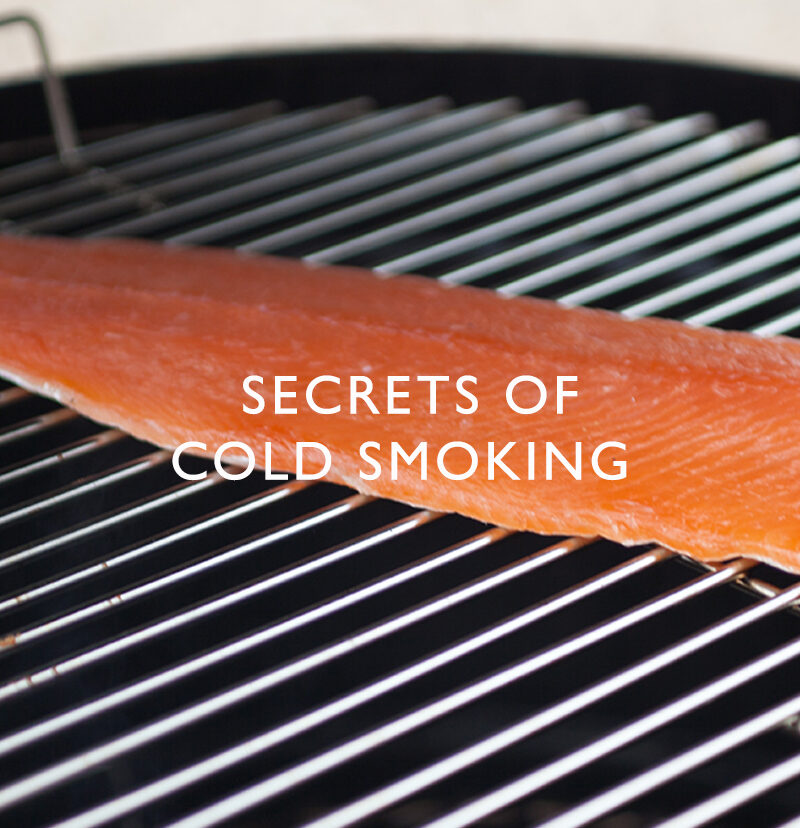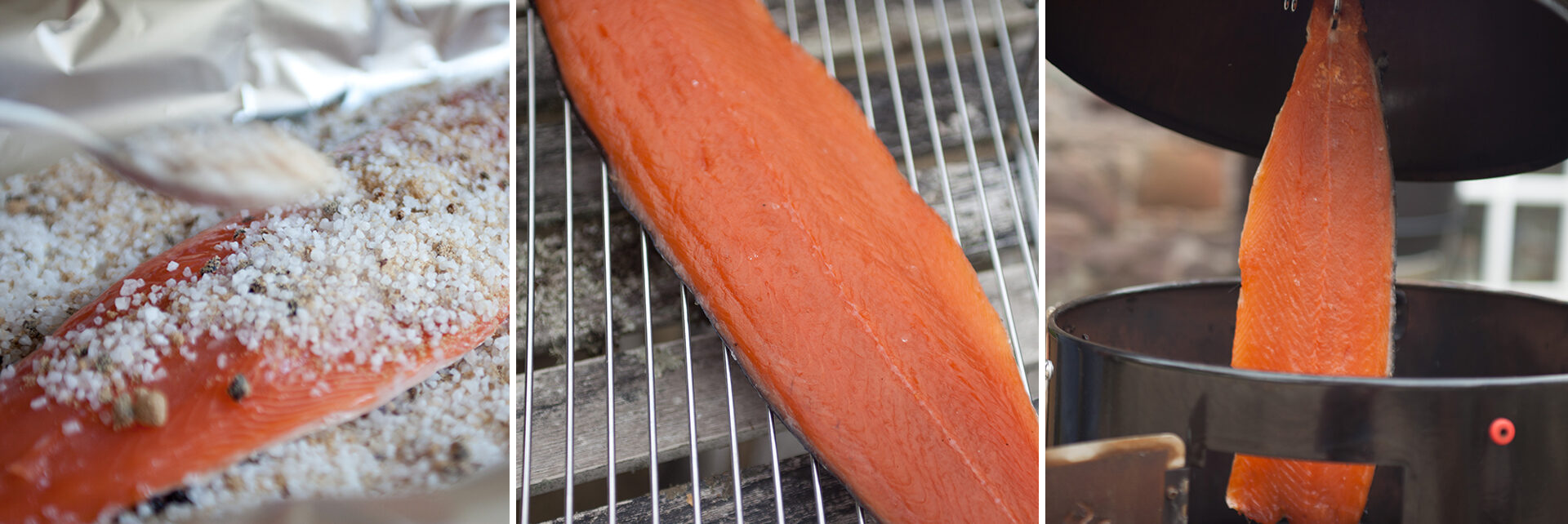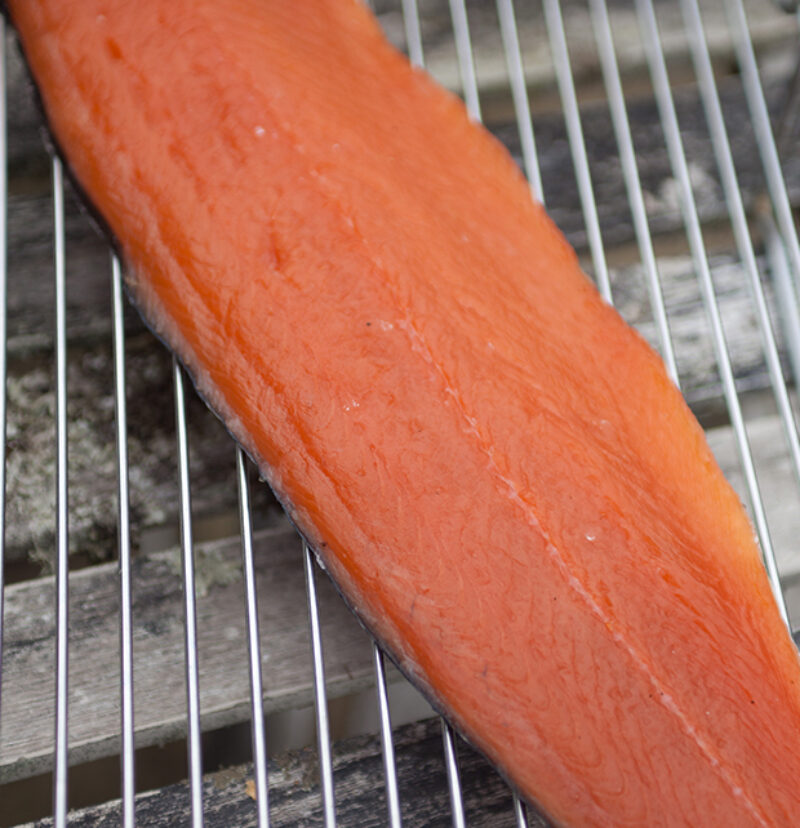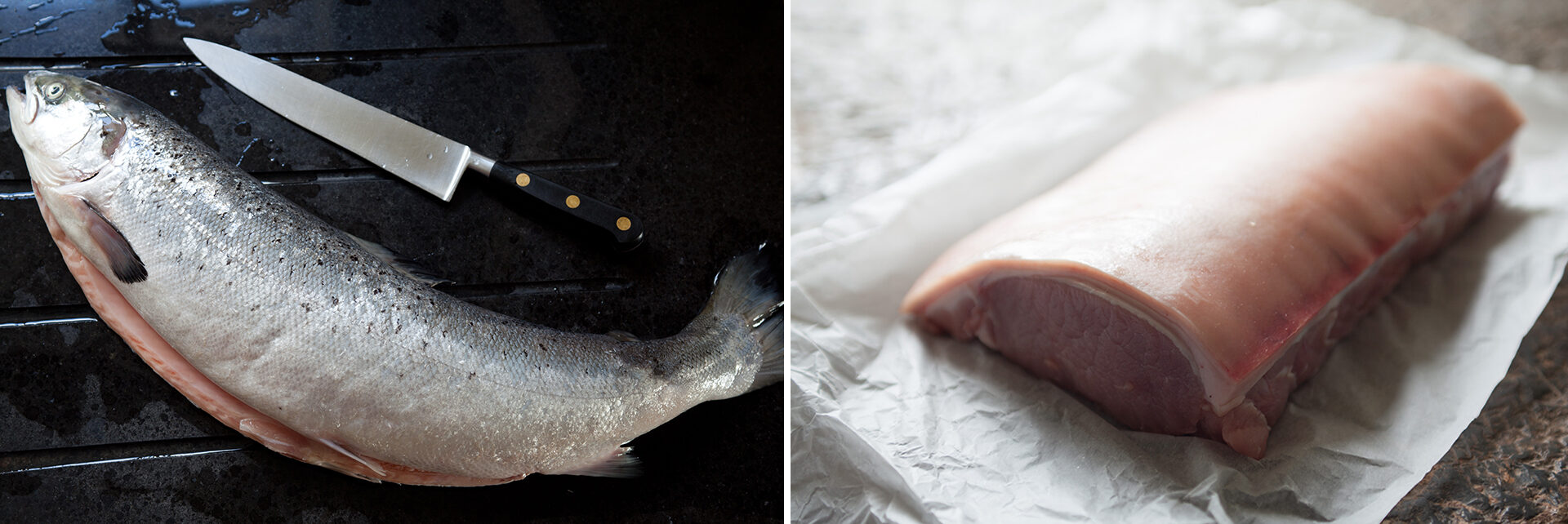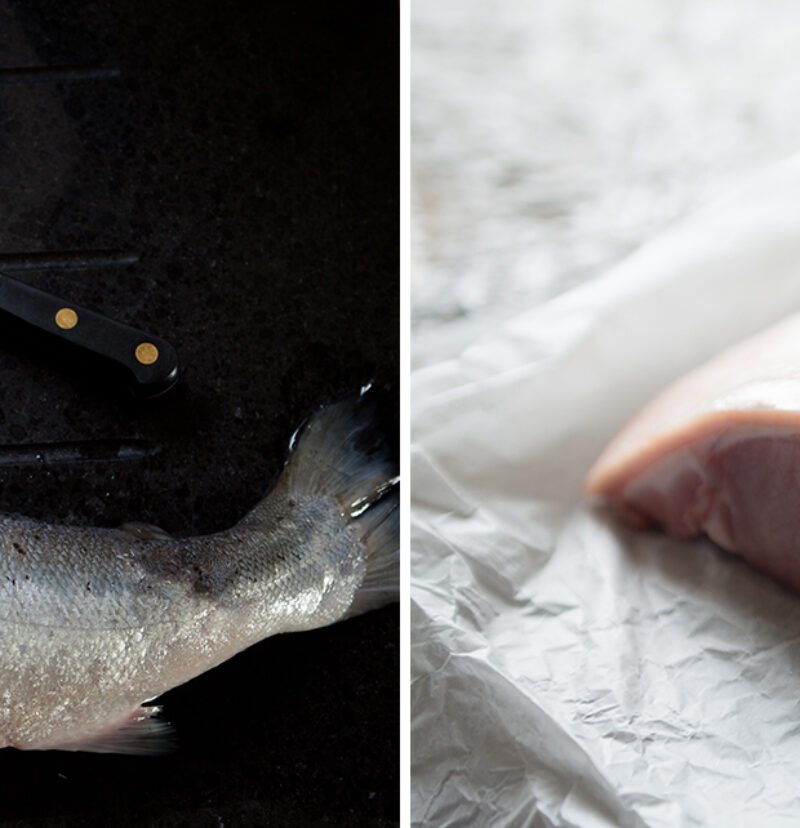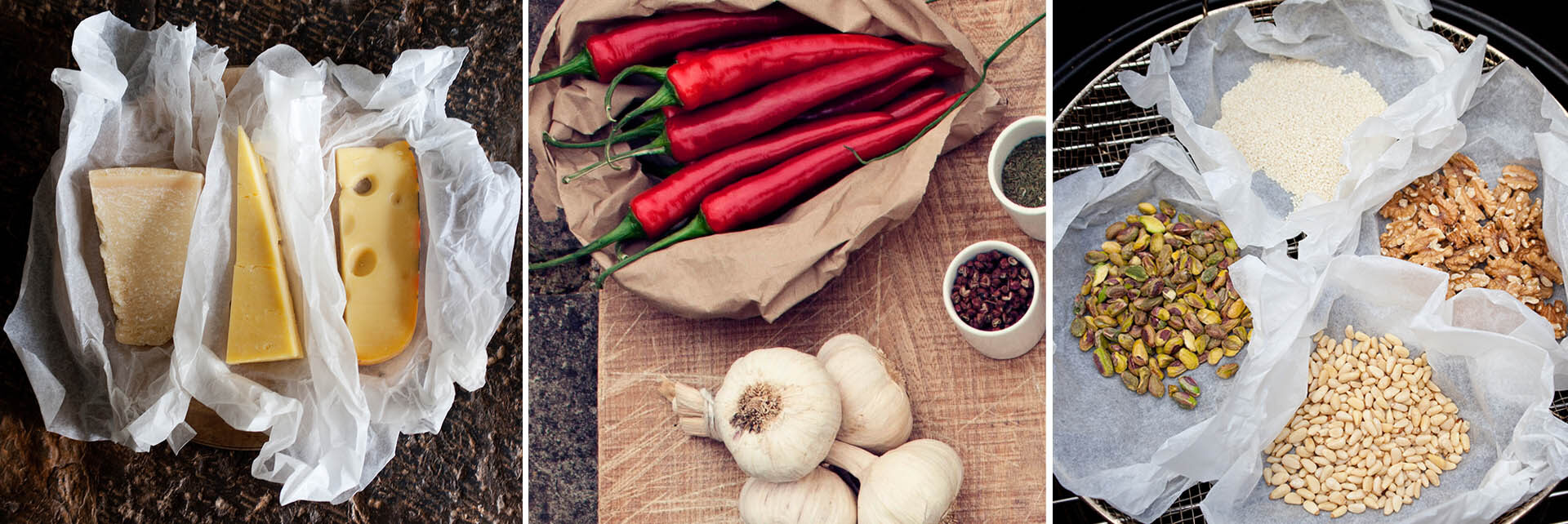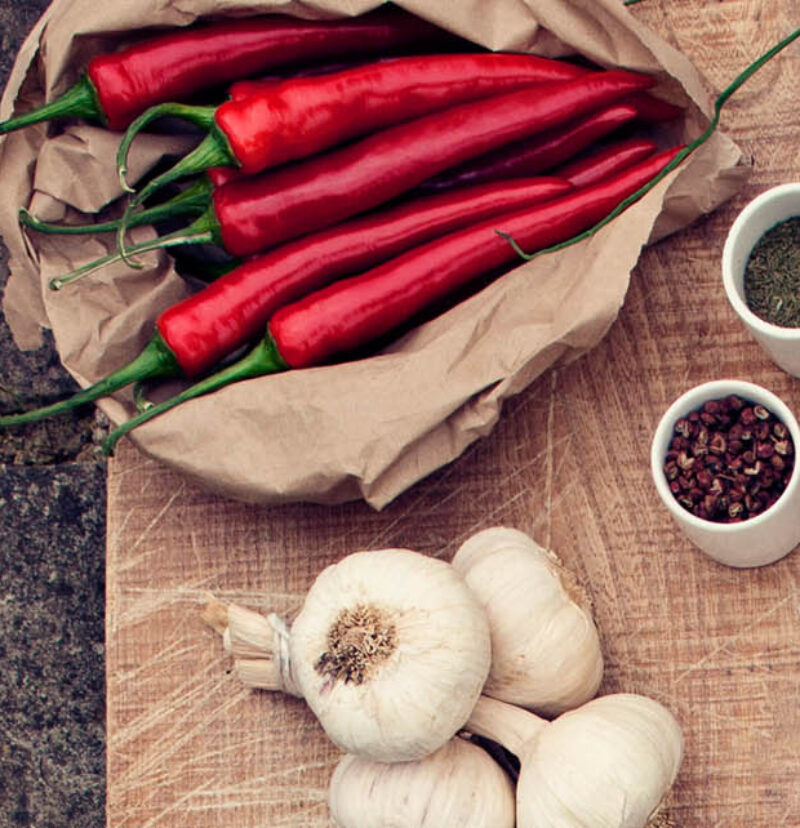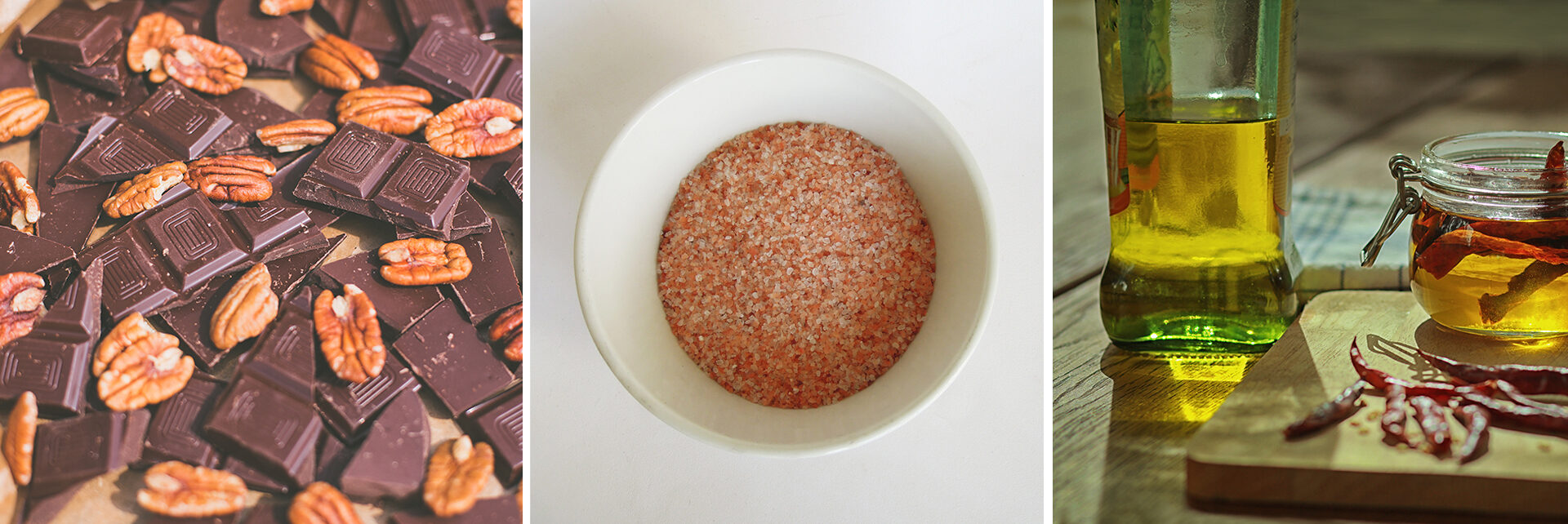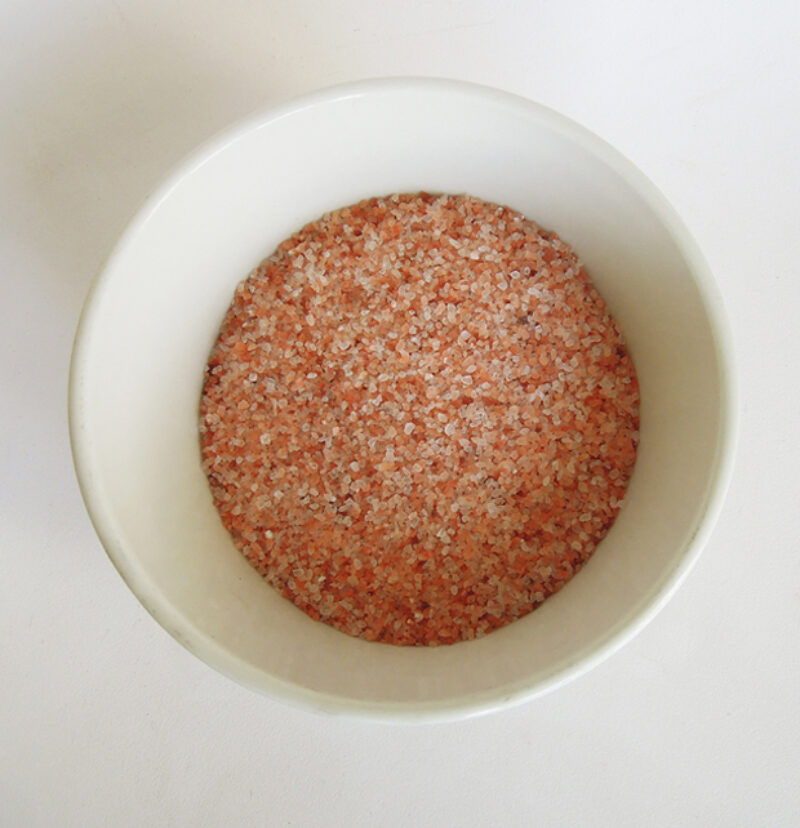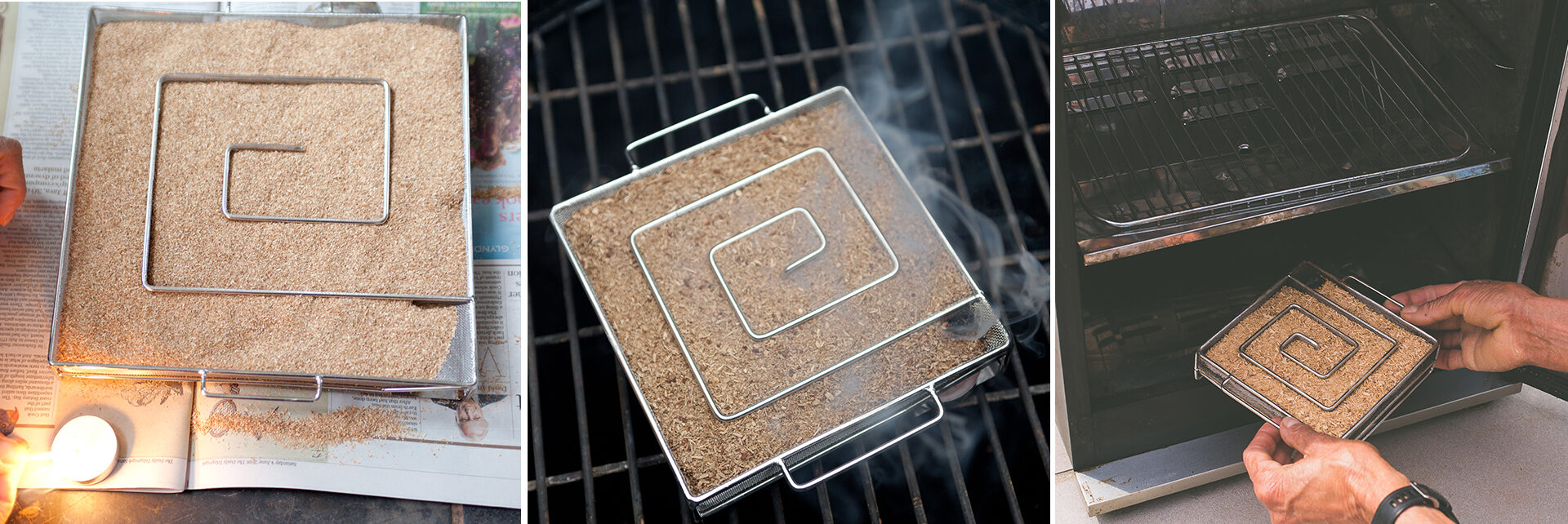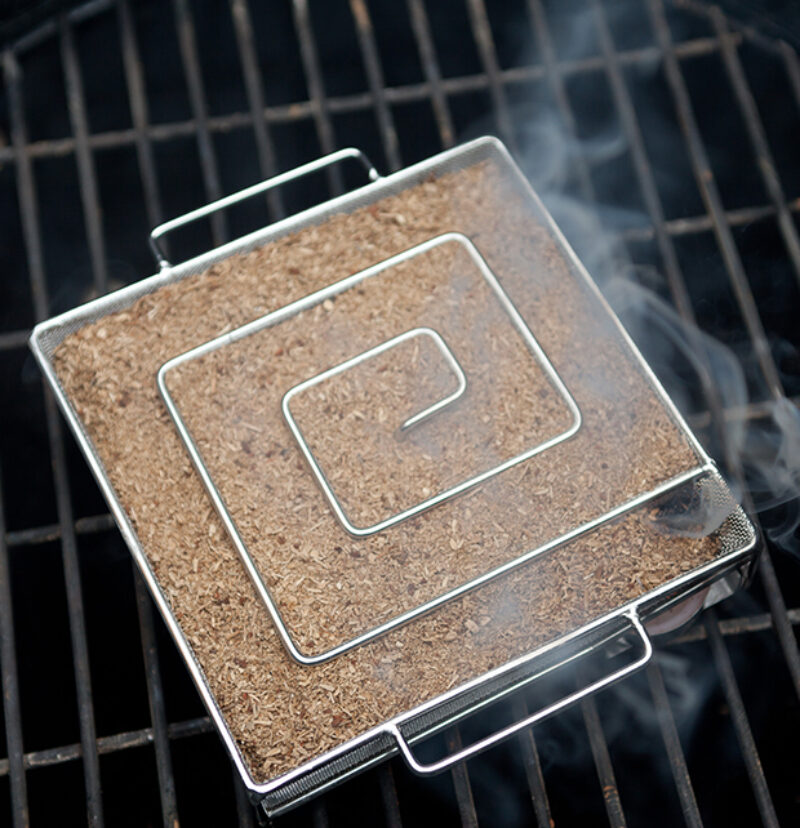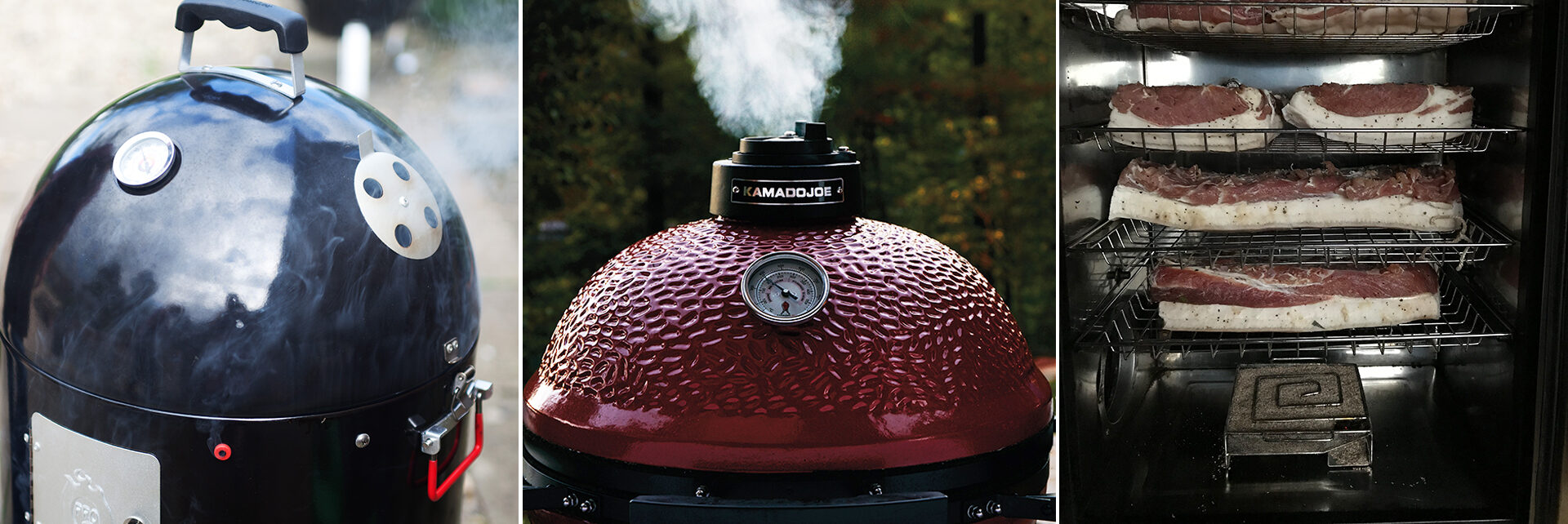COLD SMOKING INSIGHTS, TIPS & TECHNIQUES
For many the term ‘cold smoking’ immediately suggests a sort of black art, complicated by science and technical speak and requiring expensive kit. We hope to debunk some of the techy talk and re-present this wonderful culinary art so that everyone realises it’s not only within their reach but that the rewards are great.
WHY COLD SMOKE
What’s the point of cold smoking if the process is about preserving and prolonging the life of various foods? We have fridges these days! Back when meats and fish from the glut of hunting were stored above open fires to help preserve them for leaner times, salting and smoking were an absolute necessity. But in contemporary cooking we use the technique to bolster flavours we rather enjoy. The process affects texture, colour as well as taste and creates something truly delicious.
Ok, so you can pick up a pack of bacon or smoked salmon at the supermarket, but do you really know what’s gone into these larger scale, commercial processes of curing and smoking? Some smoke flavour is ‘painted’ on to food rather than inbued in the traditional way. Curing agents, whilst always within safety guidelines will err on the side of caution so there may be more chemical use than actually needed. When you cold smoke at home you know exactly what’s gone into your food.
THE PROCESS UNPICKED
Cold smoking is about adding flavour, now that the preservative need is no longer the primary objective. Consider the cooled wood smoke flavour and the salt and spice cures as extra ingredients in creating tasty foods. Cold smoked foods are essentially raw, but treated to a medley of processes to imbue flavour whilst stabilising the food and making it safe to eat. Some foods go on to be cooked further after the cold smoking process – bacon and some smoked fish – but others are ready to eat. Others, cheese, oils, chillies and dry ingredients such as nuts and seeds can be fast-tracked straight to the cold smoker requiring no preliminary curing.
The three elements of successful cold smoking are as follows. Depending on the particular recipe you will not always need all three. Gravadlax for example is cured salmon, not usually smoked. Cheeses or dry ingredients don’t require curing.
CURING The process of stabilising fresh meat or fish so it is safe to eat and will keep for longer.
DRYING A further preservative layer and preparation for the smoking phase
SMOKING The infusion of cooled smoke flavour to create a final seal and a wonderful flavour
PHASES EXPLAINED
CURING
Fresh meats and fish would quickly go off they were not cured using a salt, sugar and spices mix. Applied either as a dry cure or as a brine, through osmosis the cure draws out excess moisture from the meat or fish, otherwise a breeding ground for bacteria. Curing can take place overnight or over several weeks depending on the food and weight (eg a shoulder of ham to create serrano ham could take months and sometimes years, a couple of trout fillets, just 12 hours). By removing the moisture, the food is stablised and its shelf life prolonged, but there’s also a notable change to the food texture and colour, it will be smaller, firmer and darker in colour with enriched and intensified flavours.
There are a range of curing techniques – and don’t be put off, it really isn’t as complicated as it sounds. You can either dry cure applying a salt mix to the surface of food and allowing it to penetrate over time to draw out moisture, or you can brine by submerging food in a salt water solution. Our preference is for dry curing and we love a ‘salt plus’ approach, adding crushed whole spices and herbs. Being able to see the cure rapidly extract moisture is fascinating. The time commitment is just a few minutes over the course of a few days.
For everything you need to know about curing take a look at our Curing Edit for an in-depth look at which salts to use, dry or brine cures, nitrates etc.
DRYING
Once the cure has performed its magic, remove it as thoroughly as you can by rinsing or soaking for a few minutes in clean water which really helps remove any residual over-saltiness, dry with kitchen towel and leave uncovered on an open rack to ‘air’ somewhere cool. The bottom of the fridge is fine. Drying – think biltong – is another preservative process and a further phase of flavour intensification. Importantly, the meat or fish needs to be fully dried before exposing to wood smoke as the smoke will adhere to water droplets rather than infuse into the meat. Whilst the air circulates, the food flesh will develop a tacky surface or ‘pellicule’ and this is also key to smoke absorption. Once you’ve got this sticky surface – it could take just a few hours or overnight – you’re ready to smoke.
SMOKING
Cold smoke acts as a final seal so bacteria can no longer penetrate, but it also adds those subtle smoky flavours which make these dishes so appealing.
Cabinet temperature Cold smoking needs to take place at temperatures between 10 and 29 degrees C or at an optimum of 20 to 24 deg C. Any warmer and your food will start to cook and just a few degrees can make all the difference. If, for example, you are finding your smoked salmon texture breaks down and becomes a little soft this may because it has started to cook. Not only will the preservative qualities have been affected, but the taste will not be that of cold smoked salmon but rather a cooked salmon.
Ambient temperature can have a huge bearing on your cabinet temperature. We’ve learnt to our cost that trying to demo cold smoking cheese on a hot day at a show will end in a melted mass. Metal smoking compartments conduct heat and become ovens on particularly hot days. But this doesn’t mean you are restricted to cold smoking only in cold weather. During hotter periods, set your smoker running overnight when temperatures are lower or fill a bowl with ice and place it in the compartment to counteract too-warm air.
Although some still love the engineering-level challenge of burning woods and offsetting the heat production to deliver cooled smoke into a chamber, happily there is now an easy off-the-shelf answer to this challenge, the cold smoke generator. We talk about this in detail a little later.
With the tech challenge sorted, all you need is a ventilated compartment – just a BBQ with a lid is not only perfect for the job, but also what most of us have to hand. A 10 hour burn of the cold smoke generator will give you a generous smoke infusion, though the length of smoking time will vary according to the recipe.
Finally the source of all that lovely flavour. Wood. And not just any wood. A fine wood smoking dust is the optimum consistency for a gentle smoulder in the cold smoke generator. For more on flavour selection, see below.
WHAT FOODS TO COLD SMOKE
Fresh Meats & Fish
There are lots of classic cold smoking recipes in this category including smoked salmon, bacon and chorizo. We’ve also had great success with duck breasts, cods roe, venison and variants of pork such as pancetta and coppa. Lamb bacon is a great alternative to traditional pork or try beef bresaola or venison style proscuitto. For this category, curing is a must.
Cheese & Dairy
One of the simplest and most rewarding cold smoking projects is cheese. Unlike fresh meats and fish, cheese is ready to go straight to the cold smoking stage. Just bring it up to room temperature before it goes into the smoker.
For dense, robust flavoured hard cheeses such as cheddar or strong crumbly varieties like parmesan you need to smoke for longer, though we wouldn’t advise anything more than 10 hours – unless you are smoking a massive slab – and ideally a little less. For creamier varieties, allow them to ‘take some air’ for a few days before cold smoking to allow a drying period – not unlike the maturation process for goats cheese or ‘crottin’. The age of the crottin, starting with a very soft texture on day one, turning to a creamier ripeness and ending up with a hard exterior and almost shrunken texture after a few weeks also corresponding with the flavour intensity. We would advise working with maturer varieties for a better smoked result.
That said you can cold smoke liquid dairy products such as yoghurt. This is then used as an ingredient in bread or cakes to add an interesting taste twist. Ice cream can also be given a blast of smoke flavour and we have cold smoked dark chocolate with the main observation that it smokes quickly, so just a short burst is best.
Fruit & Veg
All varieties of chilli can be cold smoked. They need to be slightly dried first and once smoked just use as a supercharged ingredient. Garlic also takes on a beautiful smoke flavour and smoked garlic cloves are now more readily available in fruit and veg stalls and farmers markets these can then be used in the normal way as an ingredient but with an extra dimension. Fruits and dried fruits will also take a little smoke, again for use in cake baking or for chutneys and jams.
Dry Ingredients
Nuts, seeds, grains and pulses can all be cold smoked, either to create a more interesting nutritious snack or to add as an ingredient to bread, soups, stews and salads. We’ve also cold smoked giant cous cous which is technically a pasta. It took on the smoke flavour very quickly and certainly added some toasted smoke flavours.
Oils
Smoked oils are delicious and so easy to make at home. You can cold smoke olive oil – use a richer wood flavour like Oak or Hickory – rapeseed, sesame or chilli oil. Just a couple of hours will add a wonderful smoky richness to the flavour. These oils can be used for so many lovely dishes; roasting, drizzling, salad dressings, dips and frying, they can be added to sauces and pasta dishes so make great larder staples.
Salts & Spices
Salt itself, such a key component of all food smoking techniques is wonderful cold smoked as a general condiment or to add instant smokiness to any home cooking. Cold smoking works particularly well with salt crystals. The same can be said of peppercorns or cloves, though they benefit from a slight crushing first so the smoke can infuse. We’ve also tried sugar and other whole spices such as star anise. They won’t need long, just a couple of hours smoked over a mellow smoke flavour such as Beech or Maple.
EQUIPMENT
There isn’t as much dedicated cold smoking equipment on the market as you would expect – which has always been a surprise to us given how popular cold smoking is. This has probably been the reason why the challenge of generating smoke flavour has spawned a whole host of Heath Robinson style cold smokers – just search ‘cold smokers’ online and you’ll get the idea. These rely on an off-set burn method with the smoke generated by burning smoking woods over a high heat base. The smoke is then piped into the smoking chamber via an upward curve, often using a flexi ventilation style aluminium pipe or other such DIY spares. The curve traps the heat, releasing only cooler air. High tech it isn’t but it does work and we totally appreciate that creating a homemade solution is like a badge of honour in the food smoking world.
A more instant option is an off the shelf ‘cold smoke generator’, a low tech maze style contraption, just 15cm square which, when filled with a fine smoking dust, will create a long slow smouldering burn of around 10 hours, generating smoke flavour without heat. It can therefore sit inside the same chamber you use to house the food to be smoked, of which there are lots of options. This vastly simplifies the process. ProQ Smokers who originally brought out the cold smoke generator have also pioneered the production of dedicated smoking chambers, one of which is actually made of cardboard, yet works perfectly as there is no open flame in the process.
If you don’t want the outlay of this dedicated equipment you can use the ProQ cold smoke generator in your regular BBQ, so long as it has a lid and ventilation. This includes any type of BBQ – ceramic grills, gas BBQs, even pizza ovens – as well as smokers such as the electric Bradley smoker. You just need a chamber large enough to position the generator, either on the base or off to the side, and grill racks or hanging space for your food.
A quick note on hanging or using racks – it doesn’t make a difference to the end result as the smoke will circulate evenly within your enclosed chamber, however, hanging fish, chorizo or smaller cuts means you can increase the capacity in your smoking chamber. Regular BBQs may not have this hanging space depth, so just smoke flat on the racks.
If you still have the urge to create your own smoking cabinet then an adapted fridge, old kitchen cabinet, mini wooden sheld or even a metal dustbin or clean oil-style barrel will all work. Or, for an easier life, take a look at our Cold Smoking Equipment options.
WOODS FOR COLD SMOKING
Bamboozled about which flavour or wood type to choose? Here’s some guidance:
Flavour
Match wood smoke strength to the flavour of your food. Beech and Alder are the lightest and add a beautiful subtle smokiness to more delicate foods such as fish and softer cheeses. Maple, Apple and Cherry have a little more punch but are still rich and mellow and work well with pork products, salamis, some fish and chillis and garlic. For a stronger smoke opt for Oak, Hickory or Whisky Oak, a great match to lamb, nuts and oils. For our full flavour notes check out our Using Wood Smoke section.
Wood Type
Generally wood dust with a particle size of around 1 to 3mm is most suitable for cold smoking, though this does depend on the technique you are using. Wood chips or pellets would be better for an offset burn approach.
USING A COLD SMOKE GENERATOR TOP TIPS
Wood particle size is key The generator works best with an evenly, fine, small particle dust of around 1 to 2 mm in size. Any smaller such as a wood ‘flour’ then there isn’t enough air to maintain the smoulder, any larger then there’s too much air and the burn will spike, create heat and probably go out. In our smoking dust range, five are reliable generator partners due to their consistency – Oak, Beech, Maple, Whisky Oak and Cabernet Oak.
Use this hack for larger particle, variable size dust This larger dust size can work by adding an underlayer of one of the finer dusts to ensure the smoulder is maintained. Beech makes an excellent carrier in this way as it is milder in flavour (though will also subtly add to the flavour mix) so will allow the stronger flavours of these less reliable consistency dusts to come through. These woods will work on their own, just not every batch is the same being a totally natural product and occasionally the texture is just too large.
Keep your smoking dust dry Wood just loves to absorb moisture which will prevent the wood smouldering effectively. If it is a little damp, just zap it in the microwave on high for a minute to eradicate the moisture.
Smoking for less than 10 hours? 10 hours is the approximate burn time of a filled cold smoke generator but if you want to smoke something for a shorter time just fill the generator partway along the maze structure and plug the dust in place with a wad of foil.
Ventilation trial and error This can sometimes be a little difficult to perfect. Your aim is to create a gentle airflow from base to top of any smoking compartment. Calibrate using the vent controls to get this flow just right so that the generator doesn’t burn too quickly or go out. This may take some experimentation.
The weather Do be prepared for your generator to burn less reliably in damp, humid or windy conditions. Make sure any vents are positioned away from the incoming breezes. On the flip side, your generator may burn for much longer than expected in hot dry conditions.
SECRETS SUMMARY
- Cold smoking is easier than it sounds
- Three simple phases, curing, drying and smoking
- Not all foods need all three phases
- Consider cold smoking as an ingredient to boost flavour
- You can cold smoke a lot more foods than you might expect
- You don’t need expensive equipment
- You don’t need an engineering degree, just a cold smoke generator
- Use a regular BBQ as a smoking compartment
- Match wood smoke strength and length of smoking to the food type
- A fine wood dust is the optimum smoulder size for the cold smoke generator
- Keep an eye on ambient conditions which can affect burn rate and cabinet temperature
If you’d like to try some new cold smoking recipes take a look at our Recipe Collection.
We hope you have success with your cold smoking projects and we’d love to hear if you’ve uncovered any new cold smoking secrets. Email us on info@hotsmoked.co.uk or WhatsApp 07973 739053


